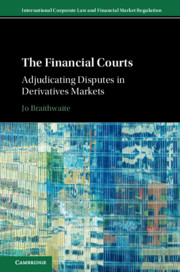19 results
10 - The Future of the Financial Courts
-
- Book:
- The Financial Courts
- Published online:
- 19 December 2020
- Print publication:
- 07 January 2021, pp 337-364
-
- Chapter
- Export citation
5 - Private Law Claims for Mis-selling
-
- Book:
- The Financial Courts
- Published online:
- 19 December 2020
- Print publication:
- 07 January 2021, pp 154-199
-
- Chapter
- Export citation
Copyright page
-
- Book:
- The Financial Courts
- Published online:
- 19 December 2020
- Print publication:
- 07 January 2021, pp iv-iv
-
- Chapter
- Export citation
3 - Interpreting the ISDA Master Agreement
-
- Book:
- The Financial Courts
- Published online:
- 19 December 2020
- Print publication:
- 07 January 2021, pp 76-119
-
- Chapter
- Export citation
9 - Challenging Choice of Law
-
- Book:
- The Financial Courts
- Published online:
- 19 December 2020
- Print publication:
- 07 January 2021, pp 312-336
-
- Chapter
- Export citation
Contents
-
- Book:
- The Financial Courts
- Published online:
- 19 December 2020
- Print publication:
- 07 January 2021, pp v-viii
-
- Chapter
- Export citation
Appendix - Legislative Framework for Contractual Jurisdiction Provisions
-
- Book:
- The Financial Courts
- Published online:
- 19 December 2020
- Print publication:
- 07 January 2021, pp 365-368
-
- Chapter
- Export citation
7 - Challenging Decision-making
-
- Book:
- The Financial Courts
- Published online:
- 19 December 2020
- Print publication:
- 07 January 2021, pp 241-278
-
- Chapter
- Export citation
Index
-
- Book:
- The Financial Courts
- Published online:
- 19 December 2020
- Print publication:
- 07 January 2021, pp 369-382
-
- Chapter
- Export citation
Table of Cases
-
- Book:
- The Financial Courts
- Published online:
- 19 December 2020
- Print publication:
- 07 January 2021, pp xiv-xxv
-
- Chapter
- Export citation
1 - The Modern Derivatives Markets
-
- Book:
- The Financial Courts
- Published online:
- 19 December 2020
- Print publication:
- 07 January 2021, pp 14-49
-
- Chapter
- Export citation
Table of Legislation
-
- Book:
- The Financial Courts
- Published online:
- 19 December 2020
- Print publication:
- 07 January 2021, pp xxvi-xxxii
-
- Chapter
- Export citation
2 - Global Markets and the English Courts
-
- Book:
- The Financial Courts
- Published online:
- 19 December 2020
- Print publication:
- 07 January 2021, pp 50-75
-
- Chapter
- Export citation
Introduction
-
- Book:
- The Financial Courts
- Published online:
- 19 December 2020
- Print publication:
- 07 January 2021, pp 1-13
-
- Chapter
- Export citation
Preface
-
- Book:
- The Financial Courts
- Published online:
- 19 December 2020
- Print publication:
- 07 January 2021, pp ix-xiii
-
- Chapter
- Export citation
8 - Challenging Choice of Jurisdiction
-
- Book:
- The Financial Courts
- Published online:
- 19 December 2020
- Print publication:
- 07 January 2021, pp 279-311
-
- Chapter
- Export citation
6 - Defensive Drafting
-
- Book:
- The Financial Courts
- Published online:
- 19 December 2020
- Print publication:
- 07 January 2021, pp 200-240
-
- Chapter
- Export citation
4 - The Regulatory Framework for Mis-selling Claims
-
- Book:
- The Financial Courts
- Published online:
- 19 December 2020
- Print publication:
- 07 January 2021, pp 120-153
-
- Chapter
- Export citation

The Financial Courts
- Adjudicating Disputes in Derivatives Markets
-
- Published online:
- 19 December 2020
- Print publication:
- 07 January 2021



